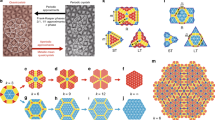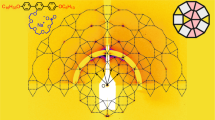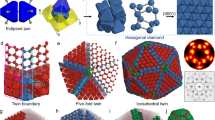Abstract
QUASICRYSTALS1have a quasiperiodic atomic structure with symmetries (such as fivefold) that are forbidden to ordinary crystals2,3. Why do atoms form this complex pattern rather than a regularly repeating crystal? An influential model of quasicrystal structure has been the Penrose tiling4, in which two types of tile are laid down according to 'matching rules' that force a fivefold-symmetric quasiperiodic pattern. In physical terms, it has been suggested1 that atoms form two or more clusters analogous to the tiles, with interactions that mimic the matching rules. Here we show that this complex picture can be simplified. We present proof of the claim5 that a quasiperiodic tiling can be forced using only a single type of tile, and furthermore we show that matching rules can be discarded. Instead, maximizing the density of a chosen cluster of tiles suffices to produce a quasiperiodic tiling. If one imagines the tile cluster to represent some energetically preferred atomic cluster, then minimizing the free energy would naturally maximize the cluster density6. This provides a simple, physically motivated explanation of why quasicrystals form.
This is a preview of subscription content, access via your institution
Access options
Subscribe to this journal
Receive 51 print issues and online access
$199.00 per year
only $3.90 per issue
Buy this article
- Purchase on Springer Link
- Instant access to full article PDF
Prices may be subject to local taxes which are calculated during checkout
Similar content being viewed by others
References
Levine, D. & Steinhardt, P. J. Phys. Rev. Lett. 53, 2477–2480 (1984); Phys. Rev. B34, 596–616 (1986).
Steinhardt, P. J. Am. Scient 74, 586–597 (1986).
Shechtman, D., Blech, I., Gratias, D. & Cahn, J. W. Phys. Rev. Lett. 53, 1951–1954 (1984).
Penrose, R. Bull. Inst. Math, and its Appl. 10, 266–269 (1974).
Gummelt, P. Geometriae Dedicata (in the press).
Jeong, H.-C. & Steinhardt, P. J. Phys. Rev. Lett. 73, 1943–1946 (1994).
Henley, C. L. in Quasicrystals, The State of Art (eds DiVincenzo, D. P. & Steinhardt, P. J.) 429–524 (World Scientific, Singapore, 1991).
Goldman, A. et al. Am. Scient. 84, 230–241 (1996).
Burkov, S. J. Phys. 2, 695–706 (1992); Phys. Rev. Lett. 67, 614–617 (1991).
Steurer, W., Haibach, T., Zhang, B., Kek, S. & Luck, R. Acta crystallogr. B49, 661–675 (1993).
Aragon, J. L., Romeu, D. & Gomez, A. Phys. Rev. B44, 584–592 (1991).
de Bruijn, N. G. K. Nederl. Akad. Wetensch. Proc. A84, 1–38 (1981).
Author information
Authors and Affiliations
Rights and permissions
About this article
Cite this article
Steinhardt, P., Jeong, HC. A simpler approach to Penrose tiling with implications for quasicrystal formation. Nature 382, 431–433 (1996). https://doi.org/10.1038/382431a0
Received:
Accepted:
Issue Date:
DOI: https://doi.org/10.1038/382431a0
This article is cited by
-
Formation of a single quasicrystal upon collision of multiple grains
Nature Communications (2021)
-
Deep Bayesian local crystallography
npj Computational Materials (2021)
-
Novel kind of decagonal ordering in Al74Cr15Fe11
Nature Communications (2020)
-
A Brownian quasi-crystal of pre-assembled colloidal Penrose tiles
Nature (2018)
-
Precipitation of binary quasicrystals along dislocations
Nature Communications (2018)
Comments
By submitting a comment you agree to abide by our Terms and Community Guidelines. If you find something abusive or that does not comply with our terms or guidelines please flag it as inappropriate.



